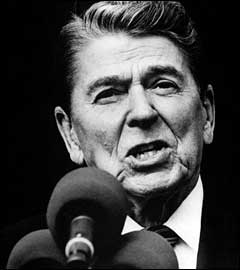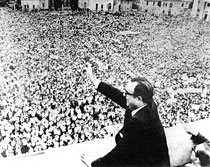Globalist Establishment Aspects of the Reagan Administration
updated May 30, 2021

This article explains establishment agendas of the presidential administration of Ronald Reagan.
Much covert military activity occurred during Reagan’s administration in Central America and the Middle East associated with the Iran-Contra Scandal, among other covert operations.
Reagan ushered in a new “Neoliberal” age with Reaganomics— which was supply-side economics with policies that appealed to producers rather than consumers. Reaganomics is also associated with reductions of government regulation of the economy, and government control of the money supply to reduce inflation.
During Reagan’s presidency the economy recovered and grew, unemployment dropped and inflation decreased, and the policies vastly increased the wealth of the top 10% of American families, while at the same time they also decreased the incomes of the bottom 10%.
This page is part of the article A Summary of Long Term Globalist Establishment Agendas of the Global Elite.
Ronald Reagan Neoconservative Agendas
Much covert military activity occurred during Reagan’s administration in Central America and the Middle East associated with the Iran-Contra Scandal, among other covert operations.

This video explains the Iran-Contra scandal that was widely reported by the mainstream media during the late 1980’s.
[Editor’s Note, Updated May 30, 2021— This documentary reports the “official view” of the Iran-Contra scandal, however it does not take the full reality of the situation into account. The popular leader of Nicaragua Anastasio Somoza was previously overthrown by communist Sandinistas who were covertly supported by the globalist Establishment during the Carter Administration, and the “Contras” who were fighting the Sandinistas were also supported by the same globalist Establishment. Also, it is shown that the Ayatollah Khomeini had been installed by the global elite in Iran to act as “controlled opposition,” instead of being “a terrorist who was secretly being appeased,” as the media tried to portray him.]
[Editor’s Note, Updated May 30, 2021— This documentary reports the “official view” of the Iran-Contra scandal, however it does not take the full reality of the situation into account. The popular leader of Nicaragua Anastasio Somoza was previously overthrown by communist Sandinistas who were covertly supported by the globalist Establishment during the Carter Administration, and the “Contras” who were fighting the Sandinistas were also supported by the same globalist Establishment. Also, it is shown that the Ayatollah Khomeini had been installed by the global elite in Iran to act as “controlled opposition,” instead of being “a terrorist who was secretly being appeased,” as the media tried to portray him.]

Among the most important autobiographies written during the 20th century is one that most people have never heard of, and it’s one that the globalist Establishment does not want people to know about. The book “Nicaragua Betrayed” is the engrossing behind-the-scenes account of the political career of Anastasio Somoza, the popular democratically elected leader of Nicaragua between 1967 and 1979, whose pro-U.S. government was overrun by Communist Sandinistas which the book proves were covertly supported by the globalist Establishment [note— “Council on Foreign Relations (CFR)”] associated with Jimmy Carter’s Administration. Somoza was assassinated in 1980 shortly after his book was published. The book is very important because it exposes the true agendas of globalism and how the Establishment global elite actually operate.

The drug kingpin “Freeway Ricky Ross” became known as “The Wal-Mart of Crack” in Los Angeles during the 1980’s by becoming the largest supplier of drugs in the area, without his initially knowing that his source of drugs was a CIA operative connected to the Iran-Contra scandal associated with George Bush and Ronald Reagan.
This compilation of video clips from the documentary film “The American Drug War: The Last White Hope” details the circumstances of the connections between Ricky Ross and the CIA, showing how the connection was publicly exposed in the media and then largely forgotten by the public while CIA drug trafficking continues.
This compilation of video clips from the documentary film “The American Drug War: The Last White Hope” details the circumstances of the connections between Ricky Ross and the CIA, showing how the connection was publicly exposed in the media and then largely forgotten by the public while CIA drug trafficking continues.
Ronald Reagan Neoliberal Agendas
Reagan ushered in a new “Neoliberal” age with Reaganomics— which was supply-side economics with policies that appealed to producers rather than consumers. Reaganomics is also associated with reductions of government regulation of the economy, and government control of the money supply to reduce inflation.
During Reagan’s presidency the economy recovered and grew, unemployment dropped and inflation decreased, and the policies vastly increased the wealth of the top 10% of American families, while at the same time they also decreased the incomes of the bottom 10%.
From Skeptically.org:
“The rise of this wave of neoliberalism culminated with the Reagan government in the United States and that of Margaret Thatcher in Britain. The Reagan and Thatcher governments not only shifted their own countries’ policies toward laissez-faire but used their control of the major Bretton Woods institutions to impose their policies on the rest of the world. For this reason, some regard neoliberalism as synonymous with the ‘Washington Consensus,’ the dominant policy view at the International Monetary Fund (IMF), the World Bank, and the U.S. Treasury at the end of the twentieth century and the start of the twenty-first. A major axiom of the neoliberal school is that (to quote Thatcher) ‘There Is No Alternative’ to globalized capitalism. This slogan is often abbreviated as ‘TINA.’
“In the late 1980s and early 1990s neoliberal policies had been embraced by the conventionally-defined center-left, as Bill Clinton of the United States backed the North American Free Trade Agreement. Free trade was seen as essential to his economic program, which promoted the creation of technology and intellectual property rights as the means by which America would be able to reduce or manage its persistent balance of trade deficit. Some centre-left neoliberal economists argued that protectionism is not a left or right issue, but an issue of asymmetry, and therefore a general cause for concern...”
“In the late 1980s and early 1990s neoliberal policies had been embraced by the conventionally-defined center-left, as Bill Clinton of the United States backed the North American Free Trade Agreement. Free trade was seen as essential to his economic program, which promoted the creation of technology and intellectual property rights as the means by which America would be able to reduce or manage its persistent balance of trade deficit. Some centre-left neoliberal economists argued that protectionism is not a left or right issue, but an issue of asymmetry, and therefore a general cause for concern...”
From “A Short History of Neoliberalism,” by Susan George:
“Over the decade of the 1980s, the top 10 percent of American families increased their average family income by 16 percent, the top 5 percent increased theirs by 23 percent, but the extremely lucky top 1 percent of American families could thank Reagan for a 50 percent increase. Their revenues went from an affluent $270.000 to a heady $405.000. As for poorer Americans, the bottom 80 percent all lost something; true to the rule, the lower they were on the scale, the more they lost. The bottom 10 percent of Americans reached the nadir: according to Phillip’s figures, they lost 15% of their already meagre incomes: from an already rock-bottom average of $4.113 annually, they dropped to an inhuman $3.504. In 1977, the top 1 percent of American families had average incomes 65 times as great as those of the bottom 10 percent. A decade later, the top 1 percent was 115 times as well off as the bottom decile.”
Article Tree
| A Summary of Long Term Globalist Establishment Agendas of the Global Elite |
| Globalist Establishment Aspects of the Reagan Administration |








